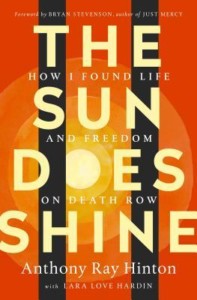 You probably don’t need me to tell you about this book, The Sun Does Shine: How I Found Life and Freedom on Death Row by Anthony Ray Hinton – it’s Oprah’s latest Book Club pick and hopefully it’s everywhere you look. What you might need me to tell you is that it is a compelling, readable story that’s definitely worth picking up. This is one of those books that should be required reading for all Americans.
You probably don’t need me to tell you about this book, The Sun Does Shine: How I Found Life and Freedom on Death Row by Anthony Ray Hinton – it’s Oprah’s latest Book Club pick and hopefully it’s everywhere you look. What you might need me to tell you is that it is a compelling, readable story that’s definitely worth picking up. This is one of those books that should be required reading for all Americans.
Anthony Ray Hinton was convicted of a crime he didn’t commit and sentenced to death in Alabama. After 30 years on Death Row, the charges against Hinton were dropped and he was set free. How could this happen? How would it feel to live most of your life waiting to die for a crime you know you didn’t commit?
Hinton’s book really puts the reader in his place as he writes about life on Death Row. He writes about trying to comfort his fellow inmates when they were upset, even though he couldn’t physically go to them. He writes about the book club he started so that Death Row inmates might have something to occupy their minds besides their own impending deaths. He writes about banging on the bars of his cell whenever an inmate was taken to the electric chair (and later lethal injection) so that inmate would know he was not alone. All the while knowing that he, himself, was innocent, even if no one believed him.
It’s riveting, terrifying stuff and this book made me cry and it made me shake with anger.
Readalikes:
- Just Mercy by Bryan Stevenson (2014; 336 pages). This book, written by Hinton’s lawyer about his work with the Equal Justice Initiative, was published several years ago before the charges against Hinton were dropped. He discusses not only Hinton’s case but others he’s worked with in the South.
- The New Jim Crow: Mass Incarceration in the Age of Colorblindness by Michelle Alexander (2010; 290 pages). Here’s another nonfiction book about the issue of prison and race in America.
- An American Marriage by Tayari Jones (2018; 308 pages). This fiction book takes a look at the incarceration of an innocent man and what it does to him and to his family, telling the story from multiple perspectives both inside and outside the jail cell.
— Abby Johnson, Collection Development Lead
